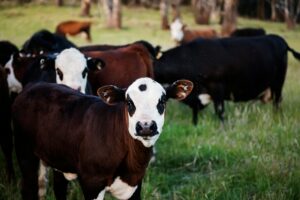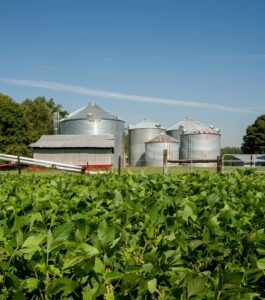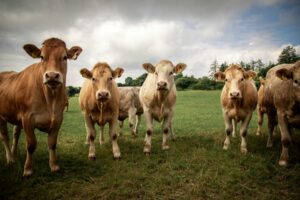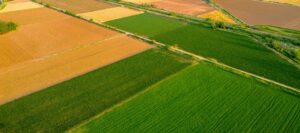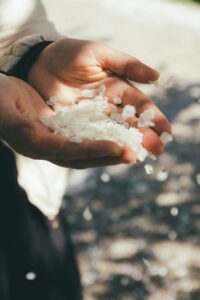Introduction
- Rooibos, Aspalathus linearis, is a natural herb found in the Cape fynbos biome. It is cultivated commercially mainly in the Cedarberg region north west of Cape Town. The plant thrives on coarse sandy soil and winter rainfall.
- It is called rooibos (‘red bush’) or Red Tea because of its colour when dried. It has a refreshing flavour and sweetish aroma, is caffeine-free and lower in tannin than black and other teas. Its anti-allergy, antioxidant and antimutagenic properties make it a healthy alternative to most hot drinks.
- Rooibos and honeybush teas (see separate page) and their health properties are valued in beverages, food flavourants, functional foods, nutraceuticals and cosmetics. Indeed, at one stage rooibos and honeybush have more than 300 trademarks and 20 patents to their names (Red Dawn IP Holdings, 2016).
- Exports could be further developed through new value-added products while, as the website https://rooibos-route.co.za shows, agro-tourism also represents a development opportunity.
International business environment
- Traditionally grown in South Africa, in the Cederberg mountains north of Cape Town, rooibos is today worth an estimated R600-million. South Africa began exporting the tea in 1904.
- Rooibos’ popularity has greatly increased which led to companies abroad in America and France making audacious bids to trademark the name. After negotiations, South Africa won geographic indicator status giving rooibos tea manufacturers of South Africa which will have ownership of that particular name and that term will be applicable only to products that come from this country. (Geographic indicator status is enjoyed by the likes of champagne, Darjeeling tea and Colombian coffee).
- The same trademark protection will apply to honeybush, another tea indigenous to the Cape region, and Karoo lamb. In turn Pretoria was forced to make a concession on feta cheese which has been protected since 2002.
Source: www.theguardian.com/world/2014/jul/28/rooibos-tea-trademark-awarded-south-africa-deal-eu
South Africa: imports and exports
Rooibos is exported to more than 50 countries across the globe, with Germany, the Netherlands, Japan, the United Kingdom and the United States of America being the biggest importers of Rooibos. The global demand for Rooibos pushed exports up from 5 900 tons per annum (2015) to 9 700 tons per annum in 2024 (Minnaar, 2025).
The annual A Profile of the South African Rooibos Market Value Chain (see “Websites and publications” heading) used to analyse major rooibos export destinations. See if the Department has resumed publishing it on www.nda.gov.za.
For the newcomer
Rooibos seeds are sown between February to March and the seedlings transplanted a few months later. It takes about 18 months before plants can be harvested for the first time. Each spring the plant is covered with small yellow flowers. Each flower produces a small legume with a single seed inside. The Rooibos seeds pop out when they are ripe and can therefore be difficult to collect. Early Rooibos farmers got hold of the local wisdom that ants harvested the seeds and that they could collect Rooibos seeds from anthills. Today, most farmers collect the seeds by sifting the sand around the plants.
During the summer harvest, the plants are cut to about 30 cm from the ground. After three to five harvests, the Rooibos plantation must be re-established.
The harvested shoots are bound into sheaves and cut to less than 4 mm. The green leaves and stems are either bruised and “fermented” in heaps (to produce traditional Rooibos) or immediately dried to prevent oxidation (for green Rooibos). The “fermentation” process involves oxidation, brought about by enzymes naturally present in the plant. During this process the product changes from green to a deep amber colour and develops its distinctive aroma. After fermentation the Rooibos is spread out to dry in the sun.
The Rooibos is sorted and graded according to length, colour, flavour and aroma. All Rooibos, whether for domestic use or the export market, is steam pasteurized to ensure a product of high microbial quality. The product is then sent in bulk (loose tea leaves) to various packers and exporters in South Africa.
Source: https://sarooibos.co.za/faq/#toggle-id-6
Local business environment
- Rooibos provides income and employment to more than 5 000 people in South Africa
- On average, about 14 000 tons of Rooibos are produced in South Africa per year
- The demand for and consumption of Rooibos in South African is around around 8000 tons.
- The increasing global demand for Rooibos pushed exports up to more than 6 000 tons per annum
- If both the export and local volumes are sold and enjoyed as pure Rooibos, this would be equal to 5,6 billion cups of tea
- The prolonged drought in the Western Cape is having a devastating effect on this sector.
Source: https://sarooibos.co.za/industry-statistics/
National strategy and government contact
The European Commission registered (May 2021) rooibos in its lists of Protected Designations of Origin (PDO) and Protected Geographical Indication (PGI). It is the first African food to receive the status.
The industry provides income and employment to approximately 8 000 agricultural workers. Other jobs are created in related activities such as processing, packaging, retailing and agritourism (SARC, 2021).
Of relevance is the Agricultural Product Standards Act: Regulations relating to Control of the Export of Processed Products.
- Department of Agriculture Directorate Marketing www.nda.gov.za
- National Agricultural Marketing Council (NAMC) www.namc.co.za
- Western Cape Department of Agriculture www.elsenburg.com
Role players
View the Premium Listings below (scroll down or click on “Premium Listings” on the Table of Contents to the right).
Further reference:
Training and research
- Find the research option under “News & Research” at www.sarooibos.co.za.
- Find information on learnerships at www.agriseta.co.za. Information on the National Certificate: Rooibos Production and National Certificate: Rooibos Processing can be viewed under the “Accredited Qualifications” option.
Websites and publications
Visit the websites listed earlier on this page.
- Find the Rooibos Biodiversity Initiative (RBI)’s Biodiversity Best Practice Guidelines for the Sustainable Production of Rooibos at www.cepf.net/Documents/rooibosguidelines.pdf
- Handbook for Implementing Rooibos Sustainability Standards, compiled by the South African Rooibos Council (SARC) and the World Wildlife Fund’s GreenChoice Alliance. The book is available in English and Afrikaans from both organisations.
- Find statistics and useful information on the SARC website at https://sarooibos.co.za.
- Find the A Profile of the South African Rooibos Market Value Chain on the Department of Agriculture Directorate Marketing’s web pages at www.nda.gov.za. Also available on the same website, among the brochures, is Brochure rooibos tea.
- “Market research on the organic and natural products and fynbos industry – with an emphasis on how to facilitate entry”, done for the Surplus People Project by Marianna Smith, includes a study of rooibos. Visit www.spp.org.za.
- Find videos on YouTube like “The story of Rooibos – the production process” and “Why you should drink red bush tea”.
- Find news of the DVDs Adapting to the wild side: Climate friendly rooibos and Everybody’s cup of tea – Living sustainably in a dry land at www.emg.org.za. The latter “documents the challenges facing small-scale Rooibos farmers in the Suid-Bokkeveld, their subsequent decision to form a co-operative to market their organic and fair-trade certified tea, and the benefits this has brought to the community”.
Some articles
- Find the articles “Rooibos boosts tilapia growth in breakthrough study, powering sustainable aquaculture”, “Rooibos farming paves way for biodiversity conservation”, “Rooibos Extracts – SA’s Global Health and Wellness Powerhouse“, “Rooibos fields unscathed by recent storms“, “Experience the Wonder of the Rooibos Harvest Season“, “Khoi and San to share in benefits of rooibos” and “Big in Japan: Rooibos booms” on our website.
- Nozulela M. 2025, November 07. “South African Rooibos tea gains foothold in China through new partnership.” IOL. Available at https://iol.co.za/business/2025-11-07-south-african-rooibos-tea-gains-foothold-in-china-through-new-partnership
- Minnaar K. 2025, August 23. “South African tea taking the world by storm.” Daily Investor. Available at https://dailyinvestor.com/south-africa/98460/south-african-tea-taking-the-world-by-storm
- Gierdien T. 2024, September 4. “Does rooibos burn fat? Stellenbosch University conducts a study…” Primedia+. Available at www.primediaplus.com/2024/09/04/does-rooibos-burn-fat-stellenbosch-university-conducts-a-study
- Trenchard T. 2024, April 25. “Sharing the revenue from South Africa’s roobios tea with the indigenous Khoisan people”. Geographical. Available at https://geographical.co.uk/culture/sharing-the-revenue-from-south-africas-roobios-tea-with-the-indigenous-khoisan-people
- Reporter, 2024, January 10. “Big win for SA’s rooibos tea market”. Bizcommunity. Available at www.bizcommunity.com/Article/196/174/245053.html
- Da Costa, W. 2023, August 5. “Rooibos used to craft beer”. IOL. Available at www.iol.co.za/ios/news/rooibos-used-to-craft-beer-b13bffe8-e74f-437f-a465-817decd37645
- Reporter. 2023, May 17. “Global fashion brands turn to Rooibos for sustainable textile dye”. Bizcommunity. Available at www.bizcommunity.com/Article/196/462/238447.html
- Ludolph N. 2022, August 11. “Podcast: sandy soil is best for rooibos tea farming”. Food for Mzansi. Available at www.foodformzansi.co.za/podcast-sandy-soil-is-best-for-rooibos-tea-farming/
- Marais S. 2022, July 15. “Khoi and San communities to earn over R12 million from rooibos”. Farmer’s Weekly. Available at www.farmersweekly.co.za/agri-news/south-africa/khoi-and-san-communities-earn-over-to-r12-million-from-rooibos/
- Bonadio E. & Contardi M. 2021, June 28. “Rooibos tea: EU protection is good news for South African agriculture”. The Conversation. Available at https://theconversation.com/rooibos-tea-eu-protection-is-good-news-for-south-african-agriculture-163502
- Reporter. 2018, September 14. “The evolution of rooibos tea, and why we love it”. Bizcommunity. Available at www.bizcommunity.com/Article/196/168/181935.html
- Cape Talk. 2018, August 8. “SA township woman’s rooibos tea bag purses all the rage in Paris”. Available at www.capetalk.co.za/articles/314591/sa-township-woman-s-rooibos-tea-bag-purses-all-the-rage-in-paris
- Van Wyngaardt, M. 2016, October 4. “Rooibos, Honeybush among South Africa’s most widely commercially cultivated plant products”. Engineering News. Available at www.engineeringnews.co.za/article/rooibos-honeybush-among-south-africas-most-widely-commercially-cultivated-plant-products-2016-10-04

